Market intelligence and monitoring are no longer a luxury reserved for a few visionaries and innovators. Every company and every department has to deal with fierce competition. The era of continuous disruption is upon us, and enterprises must be better prepared to make strategic changes based on well-informed insights to remain competitive.
In this article, we will give you an overview of the resources that you need to make it happen. As part of this guide, you will receive a selection of the most popular competitive analysis frameworks and a step-by-step process you can follow.
What is Competitive Analysis?
Competitive analysis is the collection and analysis of data from different sources to glean actionable insights about a business or organization relative to its competitive landscape.
The purpose of a competitive analysis is to obtain a better awareness of competitors, customers, and the overall market to achieve better organizational efficiency and identify strategic advantages. In other words, it helps you make better strategic choices.
However, it shouldn’t be just a feature comparison list that gets done and forgotten.
It should focus on actionable results. The goal is to provide insights and data and use them to adapt business strategy, help the sales team win in the field or achieve your goals in other ways.
Benefits of Competitive Analysis Frameworks
There are many potential benefits to using a competitive analysis framework. Conducting competitive analysis and gathering the research into a framework can help strategy teams to:
- Increase the market share
- Find market trends and patterns
- Study and understand the market
- Support an effective portfolio management
- Develop a strategy for organizational growth
- Guide Research and Development (R&D) focus
- Find new markets, assess entry challenges and ways to overcome them
- Formulate a strategy or a business plan for a new idea or product offering
- Assist in the organization’s planning for the diversification and expansion plan
- Zero in on unmet needs to transform not just their offerings, but their business models as well
- Create better operational models to fuel innovation and achieve sustained competitive advantage and growth
6 Competitive Analysis Frameworks
Porter’s Five Forces
Porter's Five Forces model is a strategic framework that helps you analyze five forces that place competitive pressure on a company in any given industry. These five forces are:
- Threat of new entrants
- Supplier power
- Buyer power
- Threat of substitutes
- Competitive rivalry
.jpeg)
With Porter's Five Forces, you'll gain a comprehensive understanding of the factors affecting your company's profitability. The next step is figuring out how to compete and claim market share.
💡 When to use it?
Porter’s Five Forces is a great way to start your industry analysis, especially for larger organizations. It’s a powerful tool that helps you identify the main players in the industry and formulate strategies to beat them. Keep in mind that you need to periodically reassess the five forces as well as keep an eye out for creative approaches taken by your competitors or newcomers. Only in this way, you will be able to reap its benefits.
📚Recommended reading:
SWOT Analysis
A SWOT analysis is a strategic planning tool that helps a business identify the internal strengths, weaknesses, and external opportunities and threats that can impact the organization's growth initiatives and pursuit of its goals.
This practice offers a structured approach to evaluate what your business does best and how it can do even better. The same approach can be applied to analyze the strengths and weaknesses of your competitors. As a result, you will be able to identify the gaps that you can fill and empower your team to make strategic moves.

With the standard SWOT analysis template, you have a grid that considers the four key elements.
Tip: SWOT analyses work best when you set up a group brainstorm where everyone makes suggestions for each category. This will speed up the process and help you uncover insights you wouldn’t be able to discover on your own.
Here’s a set of questions you can use in your brainstorming session:
- Competitor strengths: What competitor strengths pose a risk to our business? What are they doing better than us? What’s the difference between their strengths and our strengths?
- Competitor weaknesses: What are the weaknesses of our competitors that threaten their business? What are our competitors doing worse than us? Is there any negative news regarding our competitors? You can also look at their staff turnover rate or reviews that indicate their weaknesses.
As a result, you'll be able to identify where your competitors are lagging behind you. You can leverage these insights to move ahead.
- Competitor opportunities: What opportunities does our competitor have to grow, change, offer new products/services, acquire or be acquired, or establish new partnerships that could threaten our position?
- Competitor threats: What can shake up a competitor's market position? Consider both internal and external factors. Are they easily affected by supply chain disruptions? Are competitor’s products or services subject to regulatory changes?
💡 When to use it?
The SWOT analysis is a very simple tool for teams that need to stay on top of what their competitors are doing. A strategy team can use it for strategies at a corporate or business level, or it can be used by specific functional teams, such as marketing and product teams. As a result, they will be able to identify opportunities to create better strategies and develop action plans to outperform rivals.
📚Recommended reading:
Growth Share Matrix
The growth share matrix is a portfolio management framework that helps companies review their competitiveness and decide how to prioritize their different businesses. The matrix is split into four quadrants, each with a unique symbol indicating a certain degree of profitability: question marks, stars, pets (often a dog), and cash cows.
The matrix reveals two factors that companies should consider when deciding where to invest—company competitiveness, and market attractiveness—with relative market share and growth rate as their underlying factors.

Each of the four quadrants represents a specific combination of relative market share, and growth:
- Low Growth, High Share: Companies should milk these “cash cows” for cash to reinvest.
- High Growth, High Share: Companies should significantly invest in these “stars” as they have high future potential.
- High Growth, Low Share: Companies should invest in or discard these “question marks,” depending on their chances of becoming stars.
- Low Share, Low Growth: Companies should liquidate, divest, or reposition these “pets.”
The BCG matrix is not a prediction tool, but an assessment tool. As market conditions change quickly today, companies must constantly evaluate their strategies and experiment to adapt to an ever-changing environment.
💡 When to use it?
BCG matrix is best for larger organizations with diverse product ranges or multiple business units. It’s a simple framework that aids strategists and managers during the strategic analysis and planning phase.
📚Recommended reading:
Perceptual Mapping
Perceptual mapping (also known as positioning mapping) is a "mind map" of customer perceptions. It’s a diagrammatic technique used to map out how customers perceive different items, products, services, or brands. This helps you understand where customers rank your product, product line, brand, or company in comparison to rivals.

Image source: Skema Business School
In the example above, brands were ranked based on the parameters, such as quality and price. The end result helps you evaluate how much is an average customer willing to pay for a specific benefit.
Parameters on axes can vary, depending on what you want to analyze. It's best practice to consider the attributes that are most important to the average consumer’s experience.
The basis of a perceptual map is usually an industry expert's knowledge rather than market research. However, one of the easiest ways to get customer feedback is to conduct a customer survey.
When creating a new product, a company should look for a space that is unoccupied by competitors and that has a high concentration of consumer desire.
💡 When to use it?
A perception map can be used in a variety of situations. Strategists can use it to identify opportunities for new product development and additional product features. Brand managers can use it to establish their brand's position and develop differentiation strategies. It helps teams build a better product, marketing, and positioning strategies.
📚Recommended reading:
Strategic group analysis
Strategic group analysis (also known as strategic group mapping) is a framework for revealing the different market or competitive positions that rivals occupy in the industry. The goal is to answer a key question: Who is our competition?
The analysis will help you identify how your competitors compete in the industry, differentiate your brand or product and win more customers.
There are many ways in which companies within the same strategic group can be similar to one another: they might offer similar products, sell in the same price/quality range, focus on the same distribution channels, use similar product attributes to appeal to the same types of buyers, use identical technologies, or provide customers with similar technical assistance and services.
In short, industry rivals within a strategic group have similar characteristics or comparable business models.

Image source: creately.com
A simple example (in the picture above) of a strategic group would be the fast-food restaurant chains in the food service industry.
Here’s a step-by-step process you can follow to do your analysis:
- Identify characteristics that differentiate companies in one industry from one another. In this case, it is the range of menu options and price.
- Plot companies on the map and group them together based on the strategic group they fall into. For example, strategic groups in this industry include fine-dining restaurants, cafes, and family restaurants among many others. Fast-food chains differentiate from other strategic groups in terms of their relatively low prices, quick service, and variety on the menu.
- Draw circles around each group, proportional to each group's respective share of total sales.
- Identify direct competitors (companies within one circle) or cross-group rivals (circles that are closer on the map).
- The gaps on the strategic map will show you untapped market potential and possible new business opportunities.
💡 When to use it?
A strategic group map or a market map is a simple framework that assists strategy teams in strategic planning process. Use a strategic analysis to inspire innovation for business growth and to learn from the successes of competitors. You can use the results of the analysis to guide your next project with confidence knowing that it has worked before. You can also use it to help your sales team to better position your company against competitors and close more deals.
Marketing mix / 7 Ps model
The 7Ps marketing model is a framework designed to help businesses build a complete marketing strategy, from start to finish. Like with SWOT analysis, you can use the 7Ps model to perform a competitive audit and identify your rival’s marketing strategy.
When the 4Ps marketing mix was developed, businesses were more likely to sell products than services. Today, it's recommended that the full 7 elements of the marketing mix are considered when reviewing competitive strategies - across product, customer service, and more.
%2520(1).jpeg)
How to use the 7Ps model in competitive analysis?
Here’s a list of questions that can help you in the process:
1. Products/Services: How is our competitor developing products or services? Compared to our competitors, is our product or service superior in some significant way?
Keep an eye on competitor’s attendance at conferences, congresses, or trade shows to stay on top of their advancements.
2. Price/Fees: What is the competitor's pricing strategy? What are their terms and conditions of sale? Are their products or services bundled? Do we have a competitive pricing model?
3. Place/Access: Where can their customer make a purchase? Is it through a physical store or via a website? Are there any intermediaries involved in the process?
4. Promotion: How do our competitors promote themselves? What channels do they use? E-commerce or physical stores? How are they discovered by potential customers? Do they run paid ads, social media promotion, or focus on search engine optimization (SEO)? Who is their target audience?
Analyzing the marketing tactics and key metrics of your competitors, or wider market trends and updates will help to benchmark and inform your own strategies.
5. Physical Evidence: How are they signaling to customers high-quality products or services? How are they reassuring customers that they provide a high-quality experience?
For a restaurant, physical evidence could be in the form of the surroundings, staff uniform, menus, and online reviews to indicate the experience that could be expected. For a manufacturer, it could be in form of a product warranty or quality certification.
6. Processes: What is the quality of the processes that are involved in delivering the product or service to the customer? You can take a look at the management hierarchy, packaging, logistics, etc. Are their customers happy with the process?
7. People: How satisfied are customers with competitors’s customer service? Do they have any negative reviews that indicate a bad experience? What’s their company or brand reputation?
💡 When to use it?
The 7Ps of the marketing mix can serve as a well-structured checklist to help you analyze, create, or revamp your marketing strategy by providing insight into your competitors' strategies. Organizations and managers can use this framework to strategize and develop a value proposition. As a result, you’ll get a complete game plan for execution and win more customers.
How to do a Competitive Analysis?
Now that you are equipped with basic concepts and frameworks, here’s what conducting a competitive analysis actually looks like:
Step 1: Set your goals and success metrics
Focus on the results you want to get and why you’re doing it. You need to have a clear understanding of what is important to your product or organization.
If you know your goals upfront, that knowledge will help you structure the research to meet those goals:
- Do you need to supply the reasoning and analysis of why customers choose your competitor over you?
- Do you need to provide tactical support that will help sales teams close more deals?
- Do you need to help R&D or product departments to understand what are competitors working on, the strengths and weaknesses of your product, and what to prioritize from a product roadmap perspective?
- Is your research going to impact corporate or business-level strategies?
Get super clear on what you want to achieve with your analysis.
Step 2: Identify your competitors
Most likely you already have an answer. However, you don’t want to skip this step. There might be new players in the field or something happened with the old ones.
You can check with your sales team or ask your customers who they consider over you.
💡 Tip: You can use strategic group analysis to figure out who are your direct or indirect competitors.
Step 3: Conduct a comprehensive analysis & gather data
Based on your goals, you need to choose an appropriate competitor analysis framework for your analysis. You don’t have to pick only one. Combine or take bits and pieces from each to conduct a complete analysis.
A thorough analysis of this data can reveal key insights into what competitors have in the pipeline and what is on the horizon for the future.
💡 Tip: If you want to conduct a systematic, insightful and multidimensional analysis, you need to find the right team. For any analysis, it’s important to collaborate with a multidisciplinary team of internal stakeholders and external professionals if required. This will help you uncover insight that you might not be able to discover on your own.
Step 4: Distill results into actionable advice
Competitive intelligence findings are usually distributed to relevant stakeholders, such as executives, marketing teams, R&D teams, product teams, and sales groups to create a cohesive company vision and strategy informed by reliable market intelligence.
Here’s what you should absolutely avoid in this step: overwhelming your audience with unnecessary competitor data. You need to create a report and materials that your stakeholders can take immediate action on.
The key to competitive analysis is using it to problem solve and integrate insights into your strategy. It should empower key stakeholders to make strategic choices and an action plan to execute them.
💡 Tip: With each piece of competitive intel, ask yourself “so what?”. Not all product updates, technological advancements, or pricing changes have an equal impact. In fact, there shouldn’t be any action taken on the majority of “intel” you receive. Make sure each update passes the “so what?” test, and clearly explain it so that everyone can understand why it’s important for them to know.
Competitive Insights + Strategy Execution = 🚀
Competitive analysis frameworks are great for fleshing out insights and informing your strategies, but you also need the right tool to successfully execute your strategy and gain a competitive advantage.
A great strategy execution platform will help you to create a single source of truth for your strategy, eliminating wasted time in disconnected tools, confusion and potentially preventing a failed strategy execution. Even when goals change and strategy needs to be adjusted, a single home for your strategy will keep everyone on the same page.
Cascade lets your employees collaborate on shared goals to drive fast strategy execution across the organization. And outperform your competition.
Interested in seeing Cascade in action? Get started for free or book a demo with Cascade’s expert.





.png)
.jpg)
.jpg)
%20(1)%20(1)%20(1)%20(1)%20(1).png)



